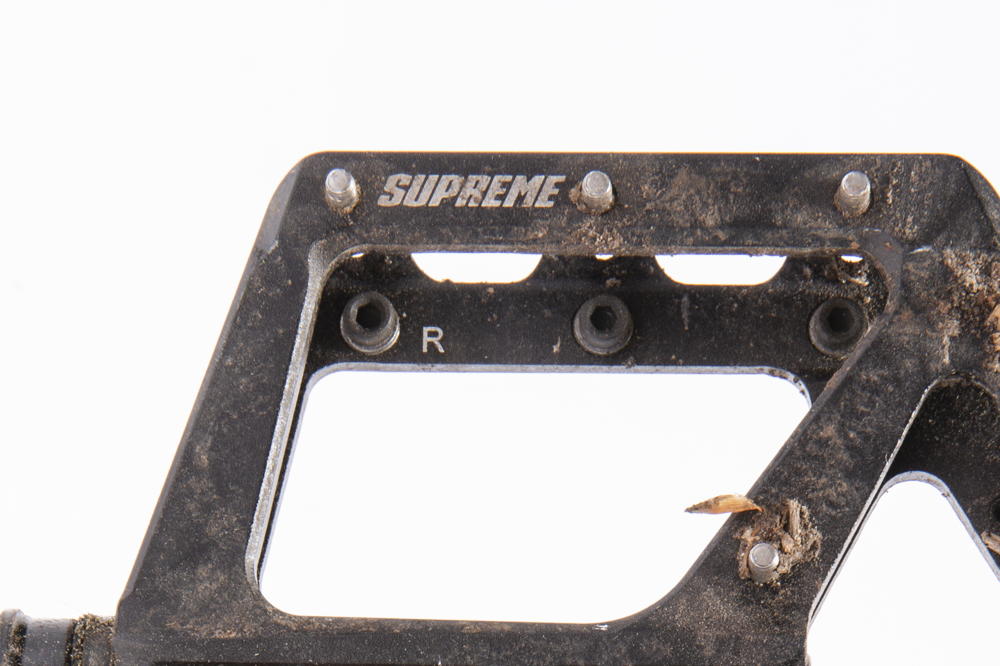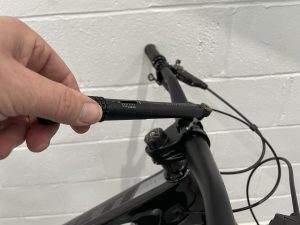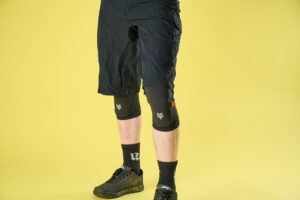Looking for the best mountain bike flat pedals, no matter what your budget? Here's our comprehensive buyer's guide to all things flat pedal.
Combined with a pair of the best mountain bike shoes for flat pedals, the extra feedback and enhanced connection with the bike and terrain you get by riding flat pedals are the main reasons that most of us here at MBR choose them over clip-in/clipless pedals. So we’re sold on the principle then, but which pedal should you buy with so many options on the market and only minimal differences in terms of appearance? If you’re looking for a guide to the best clip-in pedals, we have one of those as well.
Best MTB flat pedals – quick list
- Best budget flat pedal – Burgtec Mk4 Composite
- Best alloy flat pedal – Nukeproof Horizon Pro

The Nukeproof Horizon Pro Downhill is gripped and sorted.
1. Nukeproof Horizon Pro Downhill pedal
The ultimate alloy flat pedals
Weight: 416g | Size: 102 x 100mm | Rating: 10/10
Reasons to buy:
- The best just got better
- Is this where we say “flat pedals win medals”?
Reasons to avoid:
- Not the thinnest
- Nor the lightest
This Horizon Pro is a perfectly rounded package, that isn’t the lightest or the thinnest flat pedal on the market, but it just feels so secure underfoot. It’s proven tough over many miles, on many different bikes, ridden by many different test riders.
There are two shapes to choose from – the full-size DH model with loads of real estate for total security in the rough, or the trimmed down Nukeproof Sam Hill Enduro pedal with clipped corners to give more clearance in janky rock gardens and when sprinting on enduro stages. Both are highly rated – just make a decision based on your priorities.
Read our full test review of the Nukeproof Horizon Pro DH flat pedals

The Burgtec MK4 Composite pedal is cheap and robust.
2. Burgtec MK4 Composite pedal
Best budget nylon flat pedal
Weight: 390g | Platform size: 101 x 97mm | Rating: 10/10
Reasons to buy:
- Great all-rounders
- Durable
- Cheap
- Excellent grip
Reasons to avoid:
- Not as thin as alloy Burgtec Penthouse Flats
Burgtec has recreated its acclaimed Penthouse pedal in budget nylon, almost halving the price but without really compromising the performance. The beauty of plastic for flat pedals is that they tend to bounce, rather than crack, so they take a load of abuse. And should the worst happen, replacing them is significantly cheaper.
The Burgtec shape is superb, with a nice concavity that cups the sole of your foot. Traction via the pins is excellent and security is top notch, even on the roughest terrain. A high performance pedal at a bargain price.
Read our full test review of the Burgtec MK4 Composite flat pedals

Hope’s F22 pedals are UK made and brilliantly engineered.
3. Hope F22 pedals
Best flat pedal for durability and serviceability
Weight: 360g | Size: 105 x 102mm | Rating: 9/10
Reasons to buy:
- Decent grip and foot stability
- Durable and serviceable
- Well made
- Multiple colour options
Reasons to avoid:
- Could be more concave
- Not the biggest platform if you have large feet
Massively improved over the original version, Hope’s F22 is now worthy of your hard earned cash on a performance basis as well as in terms of looks and build quality. As you’d expect, it’s CNC-machined at Hope’s Lancashire factory, to the highest aircraft standards, and backed up by comprehensive spares and full serviceability.
Grip is now on par with all the top alloy pedals, with an improved platform shape and sharper, taller pins. Available in a rainbow of anodised colours, these pedals will be the finishing touch to any custom build.
Read our full test review of the Hope F22 pedals

Carder TenFour pedals are exquisitely made
4. Carder TenFour pedal
Coolest looking flat pedal
Weight: 422g | Size: 104 x 100mm | Rating: 9/10
Reasons to buy:
- UK-made
- Quality construction
- Good size and shape
- Loads of bite and grip
Reasons to avoid:
- More expensive than mass-produced rivals such as Nukeproof
Carder’s TenFour pedal is a sight to behold, with a stunning CNC-machined body bristling with ridges and crisp detailing. It’s made right here in the UK, and the first class construction is backed up by excellent foot security thanks to the concave platform and nine stainless steel pins.
Read our full test review of the Carder TenFour pedal

A favourite among many flat pedal riders – the DMR Vault.
5. DMR Vault pedal
Best flat pedal for a classic shape
Weight: 418g | Size: 115 x 105mm | Rating: 9/10
Reasons to buy:
- Highly concave
- Loads of colours and finishes
- They are very wide
Reasons to avoid:
- Arguably need Moto pins upgrade to get the best out of them
- They are very wide
DMR was there at the very start of the flat pedal boom, and has been at the top of the game ever since with the classic Vault. Styled after the original Shimano flat pedal, the Vault has loads of concavity to lock the ball of your foot. It’s comfortable too, but upgrading to one of the brand’s more aggressive pins will help keep your feet secure on rough alpine downhill tracks. A huge array of colours and finishes means there’s a set of pedals to suit every taste.
Read our full test review of the DMR Vault flat pedal

Pembree is another UK brand making a great flat pedal – the D2A
6. Pembree D2A flat pedal
Burly British flat pedal
Weight: 442g | Size: 110 x 100mm | Rating: 9/10
Reasons to buy:
- High quality
- Great price
Reasons to avoid:
- We’d prefer a different pin that was bottom-loading
- Not that concave
Another UK brand making CNC-machined pedals, Pembree’s offering gets a large platform with 10 stainless steep pins per side. There’s a stainless steep axle, Igus bushing and two SKF outer bearings, so they’re built to last.
For such a high quality pedal, the price is quite reasonable, and the five year warranty gives additional peace of mind.
Read our full test review of the Pembree D2A flat pedals

Canyon’s made an impressive debut with these MTB Performance flat pedals.
7. Canyon MTB Performance Flat Pedal
Top value alloy pedal
Weight: 434g | Size: 110 x 110mm | Rating: 9/10
Reasons to buy:
- Two platform size options
- Good shape
Reasons to avoid:
- In the same price bracket as established test-winning pedals
- Seals are not the best
A new product from the German direct-sales brand is this MTB Performance Flat pedal set. And for a first attempt, it has done a top job, with a similar look and feel as the top-rated DMR Vault. It’s super grippy, and the grip is adjustable by tuning the height and number of pins. Canyon also offers two platform dimensions depending on the size of your feet. Surprisingly the price is on par with rivals, and the sealing seems a bit suspect, but a great pedal nevertheless.
Read our full test review of the Canyon MTB Performance Pedal

The Nukeproof Horizon Pro Sam Hill Enduro reduces the chance of pedal strikes.
Also worth considering
Flat pedals has to be one of the most hotly contested markets in mountain biking, with hundreds of options to choose from in both metal and plastic. Fortunately we’ve tested most of them over the years, and there are quite a few pedals worth checking out that we rated highly but just missed out on a spot in this buyer’s guide.
The first ones worth mentioning are the Nukeproof Horizon Sam Hill Enduro versions. This offers the same exceptional grip as the Horizon Downhill, but with the edges chamfered for extra clearance in janky terrain.
We liked the low-profile body and well-shaped platform of the Gusset Slim Jim. It’s also decent value for money, although if you’re looking to match the colour to other parts on your bike, you’re out of luck as it only comes in black.

Save weight with the DMR Vault Mag mountain bike pedals.
It’s a similar story with the DMR Vault Mag pedals, which only come in a kind of dark grey/pewter colour. This is because they use a magnesium body to save weight. It’s only about 30g though, unless you opt for the fancy titanium axle version that brings the weight down to just over 300g and the price up to over £200. Much as the weight saving is nice, and the shape is just as secure as the alloy Vault, magnesium is softer and can get chewed up more easily – not one for rocky terrain.
Wolf Tooth offers a five-year warranty on its excellent Waveform pedals, which goes some way to justifying the £190 price tag. Well-built, with excellent bearings, and a great concave shape, it should offer peace of mind if you have deep pockets to begin with.
On the composite side, we rated the Deity Deftrap highly, with a great overall shape particularly suited to larger feet. But it’s not quite as dialled as the Burgtec Mk4 Composite, and a bit more expensive to boot.

The time HT saved coming up with a cool name, it spent on dialling in the PA03A design.
That’s not a problem with the catchily-named HT PA03A. These plastic flats are a bargain price but deliver surprisingly effective performance.
Most flat pedals are concave, but OneUp goes against the grain with a convex pedal. It’s available in metal and plastic, and delivers excellent grip, even if the price is higher than rivals and the bearing quality didn’t feel great out-of-the-box.

Like nothing else on the market – the Pedaling Innovations Catalyst.
Another unique pedal option is the Pedalling Innovations Catalyst. It’s absolutely enormous, extending well beneath the toe box of most shoes. When we tested it we were impressed by the level of support, and the lack of any pressure hotspots, but we felt like the overall grip was not up there with the best regular flats.
How we tested these flat pedals
We swapped between three of the best mountain bike shoes for flatties (Five Ten, Ride Concepts and Specialized 2FO) when testing the flat pedals here. The softness of the rubber is directly proportional to the amount of grip, but the tread pattern also influences how well a shoe grips, hence trying several designs.
 Watch the video
Watch the videoAre flat pedals good for mountain biking?
‘Flat pedals win medals’, or so the saying goes. While mountain bike flat pedals aren’t for everyone, they are incredibly popular with a lot of mountain bikers and for good reason; you can put your foot down when you need to, reposition your foot on the pedal, and not being attached to the bike is a definite plus when things start getting sketchy. They also force you to learn correct technique when it comes to bunny-hopping, pumping, and even pedalling, as you can’t be lazy and rely on an attachment between your foot and the pedal – click here for a guide to learning how to ride with flat pedals.
What to look for in the best mountain bike flat pedals:

A good flat pedal paired with a grippy shoe gives the best combination of feel, security, and comfort.
What is the best platform shape for a mountain bike flat pedal?
Slimmer, lighter platforms tend to rule modern flat pedal design, since taller pedals afford less ground clearance and aren’t as stable. Further benefits are reduced rider centre of gravity, resistance to flipping, and improved efficiency by spinning closer to the pedalling axis centre. Thinner pedals can also be made wider with equivalent clearance, which increases shoe contact for more stability and control.

A good flat pedal usually has a concave profile that lets your foot settle into.
How important is pedal concavity with a flat?
The best mountain bike flat pedals have a concave platform. This means the centre is dished to keep the ball of your foot centred and also allow you to reset it easily if removed for a dab or to stabilise in a corner. Being concave also means shoes are more resistant to inching back and forth or bouncing off on really rough terrain.

Pins engage with the sole of your shoe, helping keep your feet locked in position.
How important is platform size?
The rule of thumb is if you have big feet you want a big pedal but a bigger platform also means there’s more to aim at and it also offers more support. The downside is you have less cornering and ground clearance.

Close to the crank arm, or far away?
When it comes to pedal stance, is narrower better?
Using axles without pedal spanner flats means designers can get platforms closer to the crank arms. Platforms closer to the bike improve ground clearance and pedal stroke efficiency. One compromise can be rubbing if feet are too close to crank arms, and platforms with oversized bearing housings might also push feet outwards and dig into effective shoe area for bigger feet too. Really wide pedals generate more twist and flex in cranks, so this is a performance consideration too.

Back-loading pins are the best
What do I need to look for when it comes to pedal pins?
Stud size, layout and shape affect traction and grip. In the firing line for ground strikes, pins inevitably suffer; bottom-mounting ones are harder to strip out in an impact, and easier to move or replace because Allen key heads are less prone to damage or getting crammed with crud. Some pedal brands also offer a choice of traction studs, and height, width and thickness are critical to grip and performance.
How important are bearings and seals?
Most mid to high-end pedals have sufficient sealing, usually in the form of one or two rubber-lipped seals or O-rings to resist moisture or grit entering the bearings or bushes. The best pedals use multiple seals, with price also usually dictating bearing quality. Look for some resistance to spinning too freely too, as this can help stop pedals flipping over too readily.

SPD or flat pedals: they both need a little TLC to keep rolling smoothly
Can the best flat pedals be serviced at home?
A bearing or axle rebuild is a job most home mechanics can tackle and will make tired or baggy pedals feel fresh again (for under £20 on some models). It’s worth checking beforehand the price of new bearings or an axle on really expensive set of pedals, as, chances are, the platforms will far outlast the internals in UK conditions.

Burgtec MK4 Composite pedals are cheap, sturdy, and grippy.
What’s better; a composite or alloy pedal body?
Until recently, the answer to this question was always alloy if you were looking for a serious MTB flat pedal. But recently a crop of excellent composite/plastic/nylon pedals have emerged that are as good, and in some ways better, than their alloy competitors. Why? Well you can now get them with proper traction pins, rather than studs moulded into the body. The pins are usually secured with recessed nuts, so they’re replaceable, and in many cases the shape of the body exactly mirrors their alloy cousins. Weights are usually similar (aside from the ultra-expensive alloy pedals with titanium axles), axles and bearings are the same, and they can often be better at resisting pedal strikes – composite pedals can bounce or slide on impact rather than stick or crack. And obviously the price is very appealing – often half the price of alloy options.
















